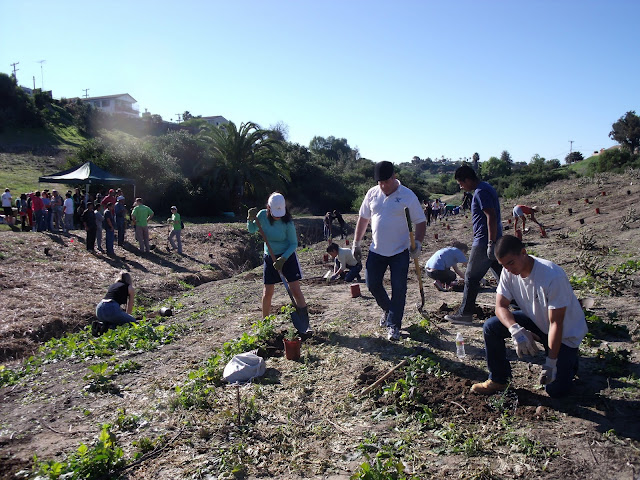
Volunteers plant vegetation to slow erosion along the banks of Chollas Creek. (Photo by Groundwork San Diego.)
Driving down side streets in southeast San Diego past paddling ducks, native sage, and ugly, graffiti-covered utility boxes offers a whiff of the promise and the menace befalling Chollas Creek.
This is no Blue Danube: Bounded and bisected by freeways, a cypher of an old creek traverses low-income neighborhoods via a series of ravines and concrete channels. Nonetheless, a local nonprofit organization has set out to salvage the creek from urban ruin. In the process, the group hopes to create a place for healing and restoration in a neighborhood sorely in need of both.
Unlike reverie-inducing waterways such as the Hudson or the Mississippi rivers, which served as engines for Americaʼs economic development, the rivers of Southern California tend to be short, quirky, and intermittent. More often than not, theyʼre considered hindrances to progress by boosters eager to make way for highways and shopping malls. Many, like Chollas Creek, have simply been entombed in concrete.
Laced with heavy metals, Chollas Creek is one of the most heavily polluted waterways in San Diego County. In the aftermath of winter storms, the lower creek can resemble a slow-moving landfill.
“We’re kind of a dumping ground for demolition and construction debris that comes from outside the neighborhoods,” says Leslie Reynolds, a former San Diego State University administrator who is leading the charge to clean up the creek.
In 2007, Reynolds founded the nonprofit Groundwork San Diego to tackle Chollas Creek head-on. She sees the cleanup as an environmental justice issue since it impacts some of the poorest parts of San Diego.
“I know I sound like a broken record, but why is this allowed to happen?” she asks on a recent midmorning tour, surveying a corridor of houses edging the creek whose ragged fencelines would not be out of place in the slums of Tijuana. She points out an intersection, known as the “Four Corners of Death,” that is ground zero for local gang activity. Even more telling are the reinforced doors and windows meant to keep the occupants safe and intruders out.
Fixing the mess will be enormously complicated, requiring the reduction of roadside pollution, stopping illegal dumping, removing invasive weeds, and perhaps most challenging of all, persuading residents to look upon the creek as a source of pride rather than an eyesore.
Still, Reynolds sees the creekʼs potential as a catalyst for change. And thanks to help from federal agencies such as the Environmental Protection Agency and the National Park Service, support from philanthropies such as the TKF Foundation, and a small army of volunteers willing to do grunt work, the creek is coming back to life, albeit in piecemeal fashion.
Work has already begun to restore the natural flow of the creek. Crews have begun eradicating invasive weeds choking the creek’s banks, and Groundwork San Diego recently mobilized hundreds of shovel-wielding volunteers to stabilize hillsides in Radio Canyon sorely in need of erosion control.
The ultimate goal is not just a less-polluted Chollas Creek, but a series of green paths and pocket parks along sections of the creek, parts of which are already in place, linking the upper reaches of the watershed with the San Diego Harbor. The greenway will traverse 23 miles and thread through densely populated neighborhoods where green space is lacking.
Hopefully, efforts to restore the creek will bind the community to a common purpose. “We just see people literally blossoming from this process,” says Christine Tanabe, a spokesperson for TKF, which recently gave Groundwork San Diego $45,000 to fund restoration planning. She hopes that “thoughtful working together” will translate into “other improvements in other aspects of their community and life.”
TFK has had prior experience coaxing similar restoration projects into existence in equally gritty sections of Baltimore and Washington, D.C., turning neglected properties into focal points for community residents and local control. In the McElderry Park neighborhood of Baltimore, the foundation helped locals transform a trash-strewn lot frequented by drug addicts into a meditation garden.
TKF is now sponsoring the “Sacred Spaces, Open Places” design competition, offering $4 million in awards — and Groundwork San Diego plans to enter. But given the inherent challenges facing Chollas Creek, can restoration efforts actually work?
Efforts to redesign the Los Angeles flood channel seemed equally quixotic, until community activists rebranded it the L.A. River and got city higher-ups to pay attention. In 2007, the city approved a river revitalization plan that tacitly acknowledged decades of poor planning decisions, and vowed to take nearby communities into account. The plan has spurred local efforts to restore the river to its original contours and to create green parkways.
South of San Diego, the town of Imperial Beach, too, has been undergoing a remarkable transformation. Wedged between Interstate 5, the Pacific Ocean, and the U.S.-Mexico border fence, Imperial Beach was California noir. It faced infrastructure challenges as daunting as Chollas Creekʼs that were exacerbated by ongoing U.S.- Mexico border tensions. After decades of local activism and a series of highly publicized events highlighting the abysmal state of water quality, crews have restored a wetland, installed basins to capture storm runoff, and seeded hillsides with native plants to prevent further erosion. It’s not Eden, but at least it’s no longer being ignored.
So perhaps, with loving care and diligence, a trashed creek in a run-down corner of San Diego can one day become an urban oasis. It’s too early to determine the ultimate fate of Chollas Creek, but it’s certainly too soon to count it out.



